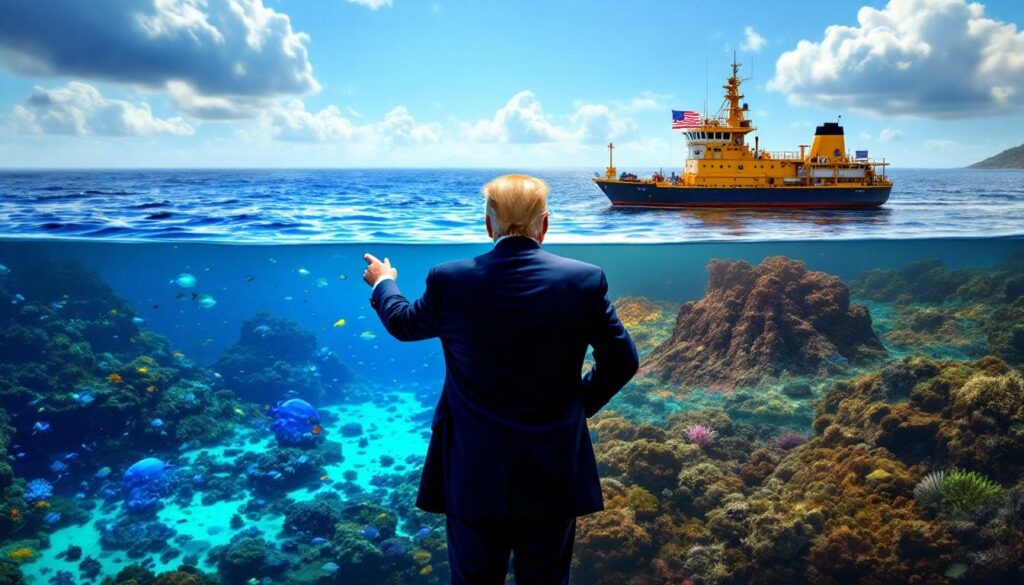Trump's Seabed Mining Plan: Exploring Potential Implications and Global Response
The concept of seabed mining for critical minerals has gained significant attention in recent years as nations seek to secure supply chains for materials essential to modern technology. This article examines the potential implications of expanded U.S. involvement in deep-sea mineral extraction, the international governance frameworks that regulate such activities, and the environmental concerns that continue to shape the debate around Trump's seabed mining plan and international backlash.
Understanding Seabed Mining Initiatives
Seabed mining represents a frontier in resource extraction, targeting valuable minerals found in international waters. These operations typically focus on polymetallic nodules benefits—potato-sized rocks containing copper, nickel, cobalt, and manganese—that lie scattered across vast areas of the deep ocean floor, particularly in regions like the Clarion-Clipperton Zone (CCZ) in the Pacific Ocean.
Any substantial U.S. push toward seabed mining would likely include several key components:
- Accelerating exploration and potential development of offshore mineral resources
- Quantifying America's accessible offshore mineral reserves
- Investing in extraction and processing technologies
- Securing supply chains for critical industries
The strategic objectives behind such initiatives typically center on:
- Reducing reliance on foreign mineral supplies, particularly from China
- Strengthening domestic production capabilities
- Supporting technological advancement in key sectors
- Enhancing national security through resource independence
Current U.S. Position on Seabed Mining
The United States maintains a complex relationship with international seabed mining governance. Despite helping negotiate the United Nations Convention on the Law of the Sea (UNCLOS), the U.S. remains one of the few nations that has never ratified the treaty, placing it in a unique position regarding deep-sea mining regulations.
"The U.S. non-ratification of UNCLOS creates a significant gray area in how American companies might operate in international waters," notes maritime law expert Dr. James Carlton. "This regulatory uncertainty presents both challenges and potential opportunities."
The Strategic Importance of Critical Minerals
Critical minerals energy transition represent the building blocks of modern manufacturing, technology development, and energy transition. Their strategic importance continues to grow as global competition for these resources intensifies.
Industries Dependent on Critical Seabed Minerals
The minerals found in deep-sea deposits are essential components in numerous high-tech applications:
| Industry | Critical Minerals Used | Applications |
|---|---|---|
| Defense | Cobalt, Manganese, Rare Earths | Missile guidance systems, radar technology, armor |
| Renewable Energy | Nickel, Cobalt, Copper | Wind turbines, solar panels, energy storage |
| Electric Vehicles | Lithium, Cobalt, Nickel | Batteries, motors, charging infrastructure |
| Electronics | Copper, Gold, Rare Earths | Smartphones, computers, telecommunications |
| Aerospace | Titanium, Aluminum, Nickel | Aircraft components, satellites, propulsion systems |
Economic Implications of Mineral Independence
Developing domestic sources of critical minerals could potentially deliver several economic benefits:
- Reduced vulnerability to supply chain disruptions
- Lower manufacturing costs through domestic sourcing
- Job creation in mining, processing, and related sectors
- Enhanced competitiveness in high-tech manufacturing
- Greater resilience against international market volatility
According to the U.S. Geological Survey, the nation is currently import-dependent for more than 50% of its supply of at least 47 mineral commodities, including many deemed critical for national security and economic prosperity. This dependency has been a driving factor behind Trump's critical minerals order.
The International Seabed Authority and Global Governance
The International Seabed Authority (ISA) plays a central role in managing deep-sea mining activities and establishing the regulatory framework for these operations globally.
Structure and Mandate of the ISA
Established in 1982 under UNCLOS, the ISA is an autonomous organization with 170 members (169 nations plus the European Union). Its core responsibilities include:
- Protecting marine environments from harmful effects of deep-seabed activities
- Developing and enforcing regulations for mineral exploration and extraction
- Managing the Clarion-Clipperton Zone and other international seabed areas
- Ensuring the "common heritage of mankind" principle is upheld
The ISA has granted 31 exploration contracts to various countries and entities, covering approximately 1.5 million square kilometers of the international seabed. These contracts allow for exploration but not commercial extraction until the ISA finalizes its mining code.
The U.S. Relationship with UNCLOS and the ISA
The United States has never ratified UNCLOS despite participating in its negotiation. This creates several complications:
- U.S. operates outside the formal ISA regulatory framework
- American companies face potential legitimacy issues when operating in international waters
- Tension exists between U.S. national interests and international governance principles
- Questions remain about enforcement mechanisms against non-member states
"The absence of U.S. participation in the ISA creates a significant governance gap in what should be a truly global regulatory regime," according to Dr. Kristina Gjerde, Senior High Seas Advisor to the IUCN Global Marine Program.
Corporate Interests in Deep-Sea Mining
Several deep‐sea mining companies have positioned themselves to potentially capitalize on seabed mining operations, with The Metals Company (formerly DeepGreen) being particularly active in this space.
Key Industry Players
The Metals Company has:
- Secured exploration rights to three contract areas in the CCZ through partnerships
- Invested heavily in research and development of nodule collection technology
- Advocated for expedited development of the ISA mining code
- Faced criticism from environmental organizations regarding its impact assessments
Other potential participants in expanded seabed mining operations include:
- Traditional mining companies reassessing their international partnerships
- Technology providers developing specialized deep-sea extraction equipment
- Processing facilities preparing for new mineral sources
- Investors weighing regulatory risks against potential profits
Mineral Grades and Quality Considerations
One driving factor behind interest in seabed mining is the quality of minerals found on the ocean floor:
- Polymetallic nodules contain on average 1.3% nickel, 1.1% copper, 0.2% cobalt, and 27% manganese
- These grades often exceed those found in terrestrial mines
- Nodules require less processing than land-based ores, potentially reducing the environmental footprint
- The minerals occur together, allowing for single-extraction efficiency
Environmental Concerns About Seabed Mining
The deep‐sea mining controversy presents significant ecological challenges that have prompted calls for caution from scientists and environmental advocates.
Potential Ecological Impacts
The environmental consequences of commercial-scale seabed mining could be substantial:
- Disruption of largely unexplored deep-sea ecosystems
- Destruction of slow-growing benthic communities that may take millions of years to form
- Sediment plumes affecting water quality and marine life far beyond mining sites
- Noise pollution affecting deep-sea mammals and other species
- Potential release of sequestered carbon from seafloor sediments
Dr. Cindy Van Dover, a deep-sea biologist at Duke University, warns: "We're at risk of causing serious harm to ecosystems we barely understand. The deep sea is the largest habitat on our planet, yet we've explored less than 0.0001% of it in detail."
Scientific Perspective on Seabed Ecosystems
The scientific community continues to highlight several crucial aspects of deep-sea environments:
- Deep ocean floors remain among the least studied environments on Earth
- Many species in these regions are undiscovered and unstudied
- Recovery rates for deep-sea habitats are extremely slow, with some estimates suggesting timescales of millions of years
- Interconnected nature of marine ecosystems means localized damage can have widespread effects
- Limited baseline data makes comprehensive impact assessment challenging
Recent studies have documented over 5,000 species living in the CCZ, with approximately 90% previously unknown to science. This biodiversity underscores the potential ecological risk of large-scale mining operations.
Global Context and Alternative Approaches
The push for seabed mining occurs within a complex international landscape where various nations have taken different approaches to seabed mineral extraction.
Other Nations' Approaches to Seabed Mining
Different countries have adopted varying positions:
- Norway recently blocked deep-sea mining licensing after political opposition
- Pacific Island nations have generally opposed seabed mining near their territories
- China has invested heavily in deep-sea exploration technology and holds multiple ISA contracts
- Japan has conducted extensive research on seafloor massive sulfide deposits
- Russia maintains active interest in Arctic seabed resources
According to a recent Greenpeace report, the growing international backlash against deep-sea mining highlights the complex geopolitical dimensions of this issue.
Alternatives to Deep-Sea Mining
Several alternatives could potentially address critical mineral needs:
- Enhanced recycling programs – Recovering minerals from used electronics and batteries
- Urban mining – Extracting valuable materials from landfills and electronic waste
- Material substitution – Developing alternatives that use more abundant minerals
- Improved efficiency – Reducing the amount of critical minerals needed in manufacturing
- Responsible land-based mining – Developing better practices for existing terrestrial operations
"The circular economy approach represents a significant opportunity to meet mineral demands while minimizing new extraction," explains resource economist Dr. Elsa Dominish. "We currently recover less than 1% of rare earth elements from consumer products."
Balancing Resource Needs and Environmental Protection
The debate around seabed mining ultimately centers on balancing global resource demands with environmental stewardship. This requires careful consideration of several factors:
Diplomatic and Governance Considerations
Any unilateral action regarding seabed mining could have significant diplomatic consequences:
- Strained relationships with ISA member states
- Potential for retaliatory measures against companies operating outside established frameworks
- Undermining of multilateral ocean governance
- Precedent-setting for other resource extraction disputes
- Impact on leadership in environmental stewardship
Possible Paths Forward
Several approaches could potentially address the tensions inherent in seabed mining:
- Negotiated compromise between national interests and international norms
- Development of parallel regulatory frameworks with mutual recognition
- Phased approach with enhanced environmental monitoring
- Technology sharing to minimize ecological impacts
- Creation of protected zones alongside extraction areas
What's at Stake for Marine Ecosystems?
The deep ocean represents one of Earth's last relatively pristine environments, with unique biodiversity and ecological functions that could be permanently altered by mining activities.
Critical Habitats and Biodiversity Hotspots
Several key deep-sea environments are particularly vulnerable:
- Seamounts and hydrothermal vents hosting specialized species
- Abyssal plains with slow-growing nodule-dependent communities
- Deep-sea coral formations that may be thousands of years old
- Migration routes for marine mammals and other pelagic species
- Carbon sequestration zones crucial for climate regulation
Research indicates that a single mining operation in the CCZ could affect an area of approximately 10,000 square kilometers—larger than Yellowstone National Park—with sediment plumes potentially impacting an even greater area.
Scientific Uncertainty and the Precautionary Principle
Many experts advocate for applying the precautionary principle to seabed mining due to:
- Limited understanding of deep-sea ecosystem recovery potential
- Unknown consequences of large-scale seabed disturbance
- Challenges in monitoring environmental impacts at extreme depths
- Difficulty establishing effective mitigation measures
- Balancing resource needs with environmental preservation
As reported by Oil Price, Trump's seabed mining plan and international backlash highlight the tensions between economic interests and environmental protection.
Key Considerations and Future Outlook
As the debate around seabed mining continues, several key questions emerge that will shape its development:
Regulatory Timeline and Developments
The ISA continues to work on finalizing its mining code, which would establish the rules for commercial extraction. This process has faced delays due to:
- Technical complexities of regulating a new industry
- Divergent perspectives among member states
- Challenges in establishing appropriate environmental standards
- Difficulty in determining fair financial arrangements
- Pressure from both industry and environmental advocates
Technology and Innovation Factors
The feasibility of environmentally responsible seabed mining hinges on technological developments:
- Precision extraction tools that minimize disturbance
- Real-time environmental monitoring systems
- Methods to contain and manage sediment plumes
- More efficient processing techniques to maximize resource recovery
- Restoration approaches for affected areas
Final Thoughts: Navigating Complex Tradeoffs
The conversation around Trump's seabed mining plan and international backlash reflects broader tensions between resource demands and environmental protection. As technological capabilities advance and mineral needs grow, the international community faces difficult decisions about how to manage the resources of the deep ocean.
"The decisions we make about the deep sea today will shape the health of our oceans for generations," notes oceanographer Dr. Sylvia Earle. "We need to proceed with extraordinary caution when it comes to disturbing ecosystems that have evolved over millions of years."
Disclaimer: This article presents an analysis of seabed mining considerations and potential implications. The regulatory landscape around deep-sea mining continues to evolve, and readers should consult current information from official sources when making decisions related to this developing field.
Want to Discover the Next Major ASX Mining Opportunity?
Explore how Discovery Alert's proprietary Discovery IQ model delivers instant alerts on significant ASX mineral discoveries, helping investors identify actionable opportunities before the broader market reacts to major finds like those discussed in this article. Visit the Discovery Alert discoveries page to understand why historic mineral discoveries have generated substantial returns for early investors.




